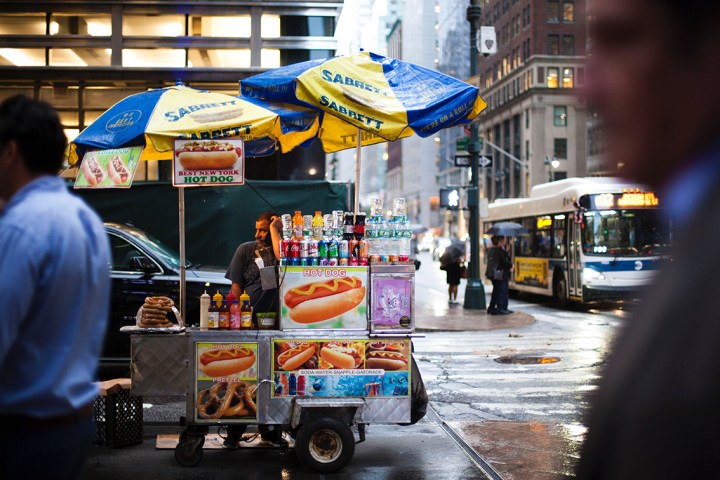RED HOT DOGS
The Birth of the Hot Dog and the world’s biggest restaurant

On the Morning After the Night Before, how can brunchers resist the innocently simple smile of a hot dog?
A hot dog has a gentle grin – and possibly a little wink – that says, “I’m here to help. Honestly.” And it’s a promise it always keeps. Only the most snobbishly stupid turn their noses up to the salving sincerity of a hot dog – or two, if not three…
The hot dog’s sausage may have been named after Frankfurt, but it was in New York where it teamed up with its inseparable buddies – a torpedo-like bun, tomatoey onion sauce, tangy sauerkraut and a zap of mustard – to become a symbol of New York that’s right up there with the Statue of Liberty.
The Porky Frankfurter becomes a Beefy New Yorker

Photo by Joseph Pearson on Unsplash
Strictly speaking, the all-beef sausage at the heart of a real hot dog isn’t a German “Frankfurter” at all.
The official tourist guide for Frankfurt says that pork is the only meat in its famous wurstschen or small sausage. To strengthen its vice-like grip on the sausage’s origins, in 1987 the city celebrated what it claimed to be its famous child’s 500th birthday.
However, according to the obviously pro-Austrian Vienna Butcher’s Guild, in 1805 a Frankfurt-trained butcher called Johann Georg Lahner started making a pork-and-beef sausage at the smokehouse he had established in Vienna the previous year.
In remembrance of the city that trained him, he called his lightly smoked mixed-meat sausage a “Frankfurter” – no doubt causing outrage in the puristly-pork city that trained him but delighting the Viennese. In fact, delighting them so much that the Lahner family stayed in the Frankfurter business until 1967.
Somewhere along the line after its Atlantic crossing to NYC, the hot dog’s sausage morphed into an all-beef affair and to this day the real thing is still cased in sheep intestine. Sort of like a cow in sheep’s clothing…
That’s not to say that a good frank is made only with finely pureed beef. Salt, garlic, pepper, paprika, water and some telling spices are typical ingredients in the hot-smoked centrepiece of New York’s most iconic street food.
It’s perhaps never tastefully wise to ask exactly what goes into any sort of mass-produced sausage. It’s nice to know that a high-quality frank’s contents are probably far less repellent than the industrialised innards of its porky-pink imitators.
The birth of the New York hot dog

Photo by Dan Smedley on Unsplash
Chances are that what you’re served by one of NYC’s many thousands of hot dog carts or “stands” features a frank from a highly reputable maker like Sabrett or Nathan’s Famous. Although the city’s street version of a hot dog often gets derisively called a “dirty-water dog”, it may well contain one of the finest franks money can buy.
New Yorkers apparently thought the new street food that began appearing in the late 1860s resembled the “sausage dog” beloved by Germans. That elongated, rusty-brown canine is more properly called a dachshund – “badger dog”. Although it took a while, the “dog” tag stuck and by 1900 it was the definitive term for a hot frank in a bun.
The New York Times of 1889 wryly praised the city’s street dog in an article titled Frankfurters On Street Stands, noting the rising availability of “fascinating and ferruginous frankfurters” served on an “oblate spheroidal roll” from pushcarts on the city’s busy thoroughfares.
“The tempting and filling brown-skinned delicacies may be procured either fried, baked, or boiled, and they are cooked to order before the eyes of the reckless purchasers.”
A cart-sold hot dog will certainly have very authentic roots. It seems that it may have been born in the very first version of such carts. In a 1988 letter to the NYT, Richard F. Snow, author of Coney Island: A Postcard Journey to the City of Fire, says the first of these wheeled “kitchens” was commissioned by a German immigrant, Charles Feltman.
Before we go there, here’s a bit of back story on Charles Feltman. He owned a wholesale bakery in south Brooklyn at a time when the adjacent Coney Island was just starting to become an attractive seaside resort hungry for New Yorkers’ money. In the early 1860s, selling bread, cakes and pies that he delivered on a pushcart, Feltman was cashing in on growing demand both from Coney’s small but expanding tourist establishments and the island’s day-trippers.
In response to repeated requests for hot food, he apparently thought a neat solution would be to offer a Frankfurter-style sausage – presumably remembered from his homeland – served hot in an easily held, hand-protecting roll which he would bake.
But how to heat the sausages? To answer that question, he visited the wheelwright who’d built his pie cart and asked if he could fit it with a water-boiling burner. According to Snow, this was probably in 1867 and this is what happened:
“Donovan [the wheelwright] cobbled one together on the spot, Feltman threw some sausages in to boil, and in a little while, there in Donovan’s shop at East New York and Howard Avenues in Brooklyn, the two men ate the world’s first two hot dogs.”
The result of this tale? To put it very mildly indeed, Feltman’s business boomed.

Photo by Roman Arkhipov on Unsplash
The hot dog builds the world’s biggest restaurant
His “Coney Island red hots” – as they were dubbed before getting their everlasting name change – sold and sold and sold. On the back of (maybe) the world’s first hot dogs, business boomed so much that Feltman was able to build an astonishing phenomenon: the biggest, most-frequented eatery in the world.
In 1871, sales of his pushcart-vended “red hots” allowed him to set up a permanent servery on Coney Island. That was followed five booming years later by the opening of Feltman’s Ocean Pavilion, a three-storey beachfront hotel with a bar and restaurant topped by two verandaed floors of guest rooms.
By the mid-’20s, the pavilion had mushroomed into a leisure complex with nine gigantic restaurants; a sedate roller coaster called the Ziz; a carousel of wooden horses; a ballroom that could handle 3,000 waltzing dancers and also double as a weekday convention centre; a huge German beer garden with stein-toting waiters in traditional Lederhosen; a Bavarian-style inn and beer hall; an outdoor cinema; a bathing pavilion with costumes and towels for hire; military bands; orchestras, and even a group of Tyrolean yodellers.
The restaurants were so incredibly popular because of their reputation for fab seafood. They were staffed by more than a thousand waiters serving over 7,000 patrons at a single sitting for lunch and dinner.
But that fishy attraction had little effect on visitors’ craving for Feltman’s foundational hot dogs. On bumper days they were buying well over 40,000 of them from seven 12-foot square iron griddles. That’s more than four tons of frankfurters being bunned-up and topped-off in a day.
Thirteen years after Feltman’s death in 1910, his two sons were running a place that served around five and a quarter million customers a year – 5.25 million… That’s an amazing legacy for a boy from Vreden in Lower Saxony who was only 14 when he arrived – alone and with no English – in New York in 1856.
That he created a pleasure zone of staggering scale and made a huge contribution to Coney Island’s development as a mega amusement park is not disputed. But did he really invent hot dogs?
His glowing obituaries in the New York Times and Brooklyn Daily Eagle say nothing at all about frankfurters or red hots.
And there’s also no place for them among the elegant statuary adorning his immense, temple-like mausoleum in Brooklyn’s ever-so upmarket Green-Wood Cemetery. The Archangel Michael standing atop the cupola is, traditionally, holding a sword – rather than a sausage in a bun. DM



 Become an Insider
Become an Insider